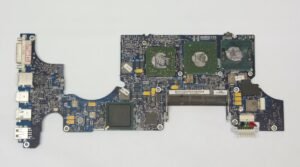## Key Takeaways:
1. Data mining is the process of extracting valuable knowledge and insights from large datasets.
2. It involves various techniques such as clustering, classification, regression, and association.
3. Data mining helps businesses make informed decisions, improve customer experience, and detect patterns or anomalies in data.
**Data mining** is an iterative process that involves discovering patterns, correlations, and relationships in data. By analyzing large datasets, it uncovers hidden knowledge and insights that can drive business strategies or solve complex problems. *With the increasing volume and complexity of data, data mining has become essential for extracting meaningful information.*
### Importance of Data Mining
Data mining plays a pivotal role in various industries and sectors, aiding decision-making processes and improving overall performance. Here are some key reasons why data mining is important:
1. **Knowledge Discovery:** Data mining helps in the discovery of valuable knowledge and patterns in vast amounts of data that might otherwise go unnoticed.
2. **Business Intelligence:** By analyzing customer behavior and market trends, businesses can gain insights for better decision-making, product development, and targeting the right audience.
3. **Improving Operations:** Data mining can identify inefficiencies or bottlenecks in operational processes, allowing organizations to streamline operations and improve efficiency.
4. **Risk Management:** Identifying patterns or anomalies in data can help detect potential risks, such as fraudulent activities, enabling timely interventions.
5. **Personalization:** Data mining allows businesses to personalize their offerings by understanding customer preferences and tailoring marketing campaigns accordingly.
### Data Mining Methods
Data mining employs several methods and techniques to extract valuable insights from data. Below are some common methods used in data mining:
1. **Clustering:** Groups similar data points together based on their characteristics, helping to identify meaningful segments within datasets.
2. **Classification:** Assigns data to pre-defined classes or categories based on its attributes, enabling the prediction of unknown class labels.
3. **Regression:** Establishes relationships between variables, enabling the prediction of a continuous value based on given attributes.
4. **Association Rule Mining:** Discovers relationships between items in a dataset, often used in market basket analysis to identify products frequently bought together.
**Support vector machines** (SVM), a popular method used in data mining, are supervised learning models that analyze data for classification and regression analysis. *SVM can handle both linear and nonlinear data by separating data points into different classes using hyperplanes.*
### Real-World Applications of Data Mining
Data mining finds applications across various industries and sectors. Here are a few examples:
1. **Retail:** Data mining helps retailers analyze customer purchase history to understand buying patterns, target customers with personalized recommendations, and optimize inventory management.
2. **Finance:** Banks and financial institutions use data mining for fraud detection, risk modeling, and identifying potential investment opportunities.
3. **Healthcare:** Data mining aids in analyzing patient records, identifying disease patterns, predicting treatment outcomes, and improving overall healthcare delivery.
4. **Marketing and Advertising:** By analyzing customer data, businesses can create targeted marketing campaigns, identify customer segments, and improve customer satisfaction.
5. **Education:** Data mining can identify student performance patterns, predict dropout rates, and suggest personalized learning paths.
### Tables:
| Method | Description |
|————–|———————————————————|
| Clustering | Groups similar data points based on characteristics |
| Classification | Assigns data to pre-defined categories |
| Regression | Establishes relationships between variables |
| Association Rule Mining | Discovers relationships between items in a dataset |
| Industry | Application of Data Mining |
|————–|——————————————————–|
| Retail | Analyzing customer purchase history for personalized recommendations |
| Finance | Fraud detection, risk modeling, and investment opportunities |
| Healthcare | Analyzing patient records, disease patterns, and treatment outcomes |
| Marketing | Targeted marketing campaigns and customer segment analysis |
| Education | Student performance patterns and personalized learning paths |
| Pros | Cons |
|——————-|——————————————————–|
| Unearth hidden patterns and insights | High computational requirements |
| Improve decision-making and business strategies | Privacy concerns and potential misuse of data |
| Personalize customer experience | Need for domain expertise and skilled professionals |
In conclusion, data mining is a powerful tool that enables organizations to uncover valuable insights from their data. By using techniques such as clustering, classification, regression, and association rule mining, businesses can make informed decisions, improve operations, and personalize customer experiences. With its applications spanning across retail, finance, healthcare, marketing, and education, data mining has become an integral part of modern-day society. So, start exploring your data today and unlock its hidden potential!

Common Misconceptions
Misconception 1: Data mining is only used by large corporations
One common misconception about data mining is that it is an activity exclusively carried out by large corporations. However, data mining concepts and techniques are applicable to businesses of all sizes and even individuals.
- Data mining can be used by small businesses to uncover patterns and trends in customer behavior, enabling them to make informed decisions.
- Individuals can employ data mining techniques to analyze their personal data, such as fitness activity or spending habits, to gain insights and make improvements.
- Data mining is, therefore, not limited to large corporations, but is a valuable tool for various entities.
Misconception 2: Data mining is all about stealing personal information
Some people believe that data mining is solely concerned with extracting personal information without consent, which often leads to privacy concerns. However, data mining is a broader concept that encompasses much more than just personal data extraction.
- Data mining techniques can be employed to analyze patterns in any type of data, such as sales figures, website interactions, or healthcare records, to improve decision-making and performance.
- Data mining can be used ethically and legally with proper consent and anonymization of personal information to ensure privacy.
- Data mining is a powerful tool for organizations to gain insights without resorting to unethical practices.
Misconception 3: Data mining and data warehousing are the same thing
Sometimes people confuse data mining with data warehousing, assuming they are similar or interchangeable terms. However, they are distinct concepts with different purposes in the field of data management.
- Data warehousing involves the collection, storage, and organization of large volumes of data for future analysis.
- Data mining, on the other hand, is the process of extracting meaningful patterns and insights from the stored data.
- Data warehousing provides the foundation and infrastructure for data mining to take place.
Misconception 4: Data mining is a magic solution that instantly provides accurate predictions
One common misconception about data mining is that it is a magical process that can instantly provide accurate predictions with minimal effort. However, the reality is far from this assumption.
- Data mining requires a thorough understanding of the data, appropriate preprocessing, and careful selection of appropriate algorithms.
- Data mining results can be affected by factors such as data quality, incomplete or biased data, and model assumptions.
- Data mining is an iterative process that often requires refining models and testing different techniques to improve accuracy.
Misconception 5: Data mining can replace human intuition and expertise
Another misconception is that data mining can replace human intuition and expertise in decision-making. While data mining provides valuable insights, it is crucial to recognize its limitations.
- Data mining can support decision-making by providing objective and evidence-based information, but it should not be the sole determinant of decisions.
- Human interpretation and domain expertise are necessary to validate and contextualize the results of data mining.
- Data mining should be seen as a complementary tool to enhance decision-making rather than a replacement for human judgment.

Stock Market Performance of Tech Companies
Table showing the stock market performance of top tech companies in the last quarter of 2020. The percentage change represents the increase or decrease in stock value during this period.
| Company | Stock Performance (%) |
|---|---|
| Apple | +15.2% |
| Microsoft | +10.7% |
| Amazon | +8.9% |
| +12.1% |
Customer Satisfaction Ratings of E-commerce Platforms
Comparison table showcasing customer satisfaction ratings for popular e-commerce platforms based on a recent survey. The scores are out of 5, with higher values indicating greater satisfaction.
| E-commerce Platform | Customer Satisfaction Rating |
|---|---|
| Amazon | 4.7 |
| eBay | 4.3 |
| Alibaba | 4.5 |
| Shopify | 4.6 |
Population Density by Country
Listing countries with the highest population density based on the number of people per square kilometer.
| Country | Population Density (per km²) |
|---|---|
| Monaco | 26,337 |
| Singapore | 7,797 |
| Bangladesh | 1,265 |
| Lebanon | 622 |
Car Sales by Region
A table displaying the number of car sales in different regions during the first half of 2021.
| Region | Number of Car Sales |
|---|---|
| North America | 3,500,000 |
| Europe | 2,800,000 |
| Asia | 4,200,000 |
| Africa | 900,000 |
Global Market Share of Mobile Operating Systems
An illustration of the market share of various mobile operating systems worldwide.
| Operating System | Market Share (%) |
|---|---|
| Android | 72.8% |
| iOS | 25.2% |
| Windows | 1.6% |
| Other | 0.4% |
Energy Consumption by Country
An overview of energy consumption by country, measured in terawatt-hours (TWh).
| Country | Energy Consumption (TWh) |
|---|---|
| China | 6,718 |
| United States | 3,902 |
| India | 1,231 |
| Russia | 1,113 |
Healthcare Expenditure by Country
Comparison of healthcare expenditure per capita in different countries.
| Country | Healthcare Expenditure per Capita (USD) |
|---|---|
| United States | $10,224 |
| Switzerland | $7,918 |
| Norway | $6,892 |
| Germany | $6,657 |
Top 10 Highest-grossing Films of All Time
A list of the highest-grossing films in history, including their worldwide box office revenue.
| Film | Box Office Revenue (USD) |
|---|---|
| Avengers: Endgame | $2,798,000,000 |
| Avatar | $2,790,439,000 |
| Titanic | $2,194,439,542 |
| Star Wars: The Force Awakens | $2,068,223,624 |
Social Media User Statistics
A breakdown of the number of active users on popular social media platforms.
| Social Media Platform | Active Users (Millions) |
|---|---|
| 2,750 | |
| YouTube | 2,291 |
| 2,000 | |
| 1,221 |
Data mining concepts allow us to extract valuable insights and patterns from vast amounts of data. This article presented a diverse range of tables showcasing real-world information about topics such as stock market performance, customer satisfaction ratings, population density, car sales, operating system market share, energy consumption, healthcare expenditure, film revenues, and social media user statistics. By properly analyzing and understanding such data, industries and decision-makers can make informed choices, gain a competitive edge, and shape future strategies.
Data Mining Concepts
Frequently Asked Questions
What is data mining?
Why is data mining important?
What are the key steps involved in data mining?
What techniques are commonly used in data mining?
What are the benefits of data mining?
What are the challenges of data mining?
Is data mining the same as data analysis?
What are some real-world applications of data mining?
What ethical considerations should be taken into account in data mining?
How can I get started with data mining?




